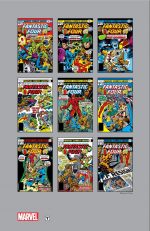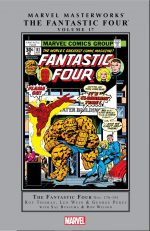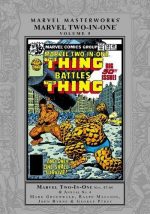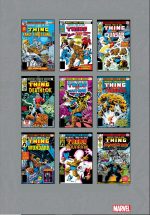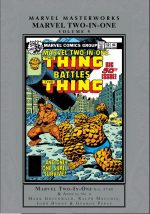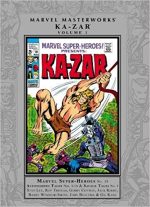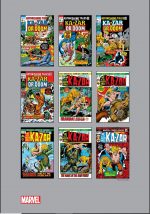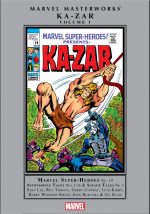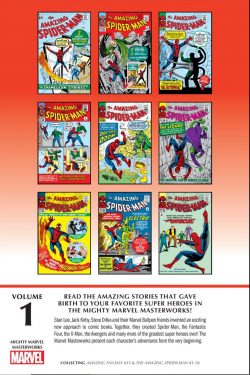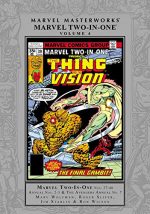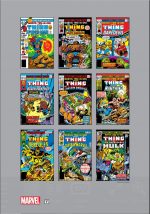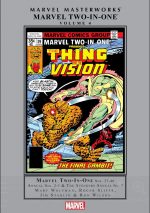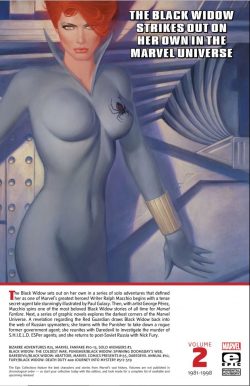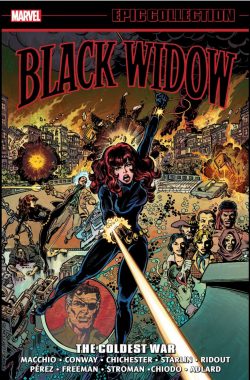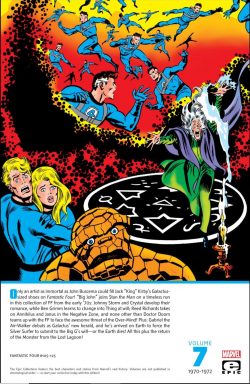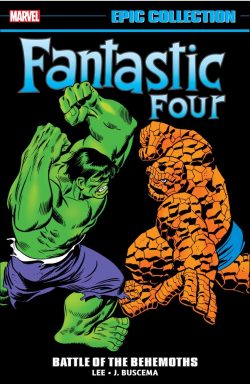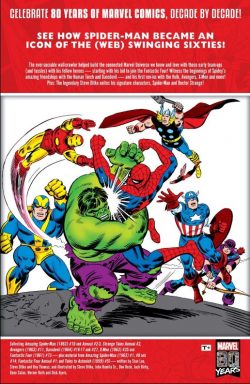

By Stan Lee, Steve Ditko, Roy Thomas, Jack Kirby, Don Heck, Dick Ayers, John Romita Sr, Gene Colan, Werner Roth & various (Marvel)
ISBN: 978-1-3029-1660-2 (TPB)
The Amazing Spider-Man was first seen in the middle of 1962, so expect plenty of wallcrawling reviews over the next twelve months, and if any of us make it to the end I’m sure we’ll all be well-versed in Arachnid Lore with our book shelves (physical or digital) positively groaning with sublimely re-readable tales and tomes…
For Marvel, it’s always been all about the team-ups…
In the company’s 80th Anniversary year of 2019, they published plenty of reprint material in archival formats designed to highlight specific triumphs of the House of Ideas. One of the mot interesting was the Decades project: collecting material from each era seen through a themed lens. For the 1960s – with so very much astounding innovation to be proud of – the editors opted to re-present critical confrontations of the company’s signature star with the other breakthrough characters that formed the bedrock of the Marvel Universe. After all, it’s always been all about the team-ups…
Within this trade paperback/digital delight – in full or in extract – are bombastic battles and eccentric encounters between the wondrous wallcrawler and the other growing stars of the ever-expanding firmament, culled from Amazing Spider-Man #1, 8, 14, 16; Amazing Spider-Man Annual #2; Fantastic Four #73; Fantastic Four Annual #1; Strange Tales Annual #2; Tales to Astonish #57; The Avengers #11; The Avengers Annual #3; Daredevil #16, 17, 27 and The X-Men #35 spanning March 1963 to 1968. The curated cruise begins with a context-setting Introduction from Jess Harrold, before we see a skinny kid in a costume meet his heroes for the first time…
Marvel is often termed “the House that Jack Built†and Kirby’s contributions are undeniable and inescapable in the creation of a new kind of comic storytelling, but there was another unique visionary toiling at Atlas-Comics-as-was, one whose creativity and even philosophy seemed diametrically opposed to the bludgeoning power, vast imaginative scope and clean, broad lines of Jack’s ever-expanding search for the external and infinite.
Steve Ditko was quiet and unassuming, voluntarily diffident to the point of invisibility, but his work was both subtle and striking: simultaneously innovative and meticulously polished. Always questing for the ideal, he explored the man within. He saw heroism and humour and ultimate evil all contained within the frail but noble confines of humanity. His drawing could be oddly disquieting… and, when he wanted, decidedly creepy.
Crafting extremely well-received monster and mystery tales for and with Stan Lee, Ditko had been rewarded with his own title. Amazing Adventures/Amazing Adult Fantasy featured a subtler brand of yarn than Rampaging Aliens and Furry Underpants Monsters: an ilk which, though individually entertaining, had been slowly losing traction in comics ever since DC had successfully reintroduced costumed heroes.
Lee & Kirby had responded with Fantastic Four and the ahead-of-its-time Incredible Hulk but there was no indication of the renaissance ahead when officially just-cancelled Amazing Fantasy featured a brand new and rather eerie adventure character…
It wasn’t a new story, but the setting was familiar to every kid reading it and the artwork was downright spooky. This wasn’t the gleaming high-tech world of moon-rockets, mammoth monsters and flying cars… this stuff could happen to anybody…
The debut of Spider-Man and his pathetic, loser, young alter ego Peter Parker was a landmark moment. The hard luck hero effortlessly made the jump to his own title. Holding on to the “Amazing†prefix to jog reader’s memories, the bi-monthly Amazing Spider-Man #1 arrived with a March 1963 cover-date and two complete stories. It also prominently featured the aforementioned FF and took the readership by storm. Excerpted here are the 5 pages wherein the cash-strapped youngster breaks into the Baxter Building determined to get himself hired by the team and ends battling his idols…
That’s followed by a back-up story from 1963’s Fantastic Four Annual #1 which expanded the incident into a proper yarn. ‘The Fabulous Fantastic Four Meet Spider-Man‘ sees Kirby redraw the moment with Ditko inking and it is superb, smartly segueing into the lead feature from the same year’s Strange Tales Annual #2. This terrific romp from Lee, Kirby & Ditko depicts an early Marvel Misapprehension as the wallcrawler is framed by international art thief and disguise-master The Fox, and hot-headed Johnny Storm determines to bring the aggravating arachnid to justice. Guess how that works out…
Cover-dated January 1964, Amazing Spider-Man #8 led with a battle against the computer dubbed the Living Brain, but you’ll need to look elsewhere for that. An extra vignette in that issue provided another Lee/Kirby/Ditko delight. ‘Spiderman Tackles the Torch!’ is a 6-page comedy romp wherein a boisterous and envious wall-crawler gate-crashes a beach party thrown by the flaming hero’s girlfriend… with suitably explosive consequences.
Marvel’s growing band of stars were pooping up everywhere in others titles by this time, and the next snippet – 5 pages culled from Amazing Spider-Man #14 (July 1964) – sees the webspinner’s battle against the Green Goblin and Enforcers interrupted by the Incredible Hulk who delivers an unforgettable lesson in staying in your own weight class. That same month, Tales to Astonish #57 saw Giant-Man and the Wasp ‘On the Trail of the Amazing Spider-Man!’ – courtesy of Lee, Dick Ayers & Paul Reinman – with sinister mastermind Egghead pulling strings to make the complete strangers into mortal enemies…
September 1964 found Amazing Spider-Man #16 extending the wallcrawler’s circle of friends and foes whilst battling the Ringmaster and his Circus of Evil and encountering freshly minted fellow loner hero in a dazzling and delightful‘Duel with Daredevil’ (Lee & Ditko), after which The Avengers #11 (by Lee, Don Heck & Chic Stone) details how ‘The Mighty Avengers Meet Spider-Man!’ This is a clever and classy cross-fertilising tale featuring time-bending tyrant Kang the Conqueror who attempts to destroy the team by insinuating within their serried ranks a robotic duplicate of the outcast hero.
Next up is arguably Ditko’s greatest artistic triumph of this era: the lead tale from Amazing Spider-Man Annual #2 (October of that year and filled out with vintage Spidey classics).
Ditko was on peak form: fast enough to handle two monthly strips, and at this time also blowing away audiences with another ill-fitting, oddly tangential superhero. The disparate crusaders met in ‘The Wondrous World of Dr. Strange!’: an entrancing fable unforgettably introducing the Amazing Arachnid to arcane realities and metaphysical mysteries as he joins the Master of the Mystic Arts to battle power-crazed mage Xandu in a phantasmagorical, dimension-hopping masterpiece involving ensorcelled zombie thugs and the stolen Wand of Watoomb. After this, it was clear that Spider-Man could work in any milieu and that nothing could hold him back…
Now sporting his signature all-red outfit, the Man Without Fear re-encountered Spider-Man in Daredevil #16-17 (May & June 1966 and crafted by Lee, John Romita the elder and inker Frank Giacoia) as ‘Enter… Spider-Man!’ introduces diabolical criminal mastermind Masked Marauder who has big plans; the first of which is to get DD and the wallcrawler to kill each other…
With chapter ‘None are so Blind…’ opens a convoluted a sub-plot which would lead to some of the highest and lowest moments of the early Daredevil series – such as Spidey accusing Law-firm partner Foggy Nelson of being the Scarlet Swashbuckler and Matt Murdock inventing a twin brother Mike – but the art is superb and the action is nonstop, so there’s not much to complain about…
Next comes Amazing Spider-Man Annual # 3 and ‘…To Become an Avenger!’ with the World’s Mightiest Heroes offering the webspinner membership if he can capture and bring them the Hulk. As usual, all is not as it seems but the action-drenched epic, courtesy of Lee, Romita (on layouts), Don Heck, & Mike Esposito is the kind of guest-heavy, power-punching package that made these summer specials such a prize…
Jumping to April 1967, Daredevil #27 (Lee, Gene Colan & Giacoia) closes a chapter as a leaner, moodier Man Without Fear manifested. Earlier episodes saw the hopeless romantic triangle of Murdock, best friend Foggy and their secretary Karen Page become a whacky quadrangle by introducing fictitious twin Mike Murdock. Now he would be “exposed†as Daredevil to divert suspicion from the blind attorney who actually battled all those weird villains…
Well that happened, and – still skulking in the background – arch-villain Masked Marauder slowly honed in on DD’s actual alter ego. He got closest in ‘Mike Murdock Must Die!’ after Stilt-Man teams with the Marauder before Spider-Man abrasively helped out in a brief cameo to take down the long-legged loon…
Cover-dated August 1967, The X-Men #35 finally found Marvel’s top teens in the same story. At that time the mutant heroes were hunting secret cabal Factor Three who had used robot arachnoids to kidnap Professor X.
When ally Banshee is captured mid-sentence during a crucial communication with the team in ‘Along Came A Spider…’(by Roy Thomas, Werner Roth & Dan Adkins) everybody’s favourite wallcrawler is mistaken for a foe. After the desperate, distraught mutants find the hero amidst robot wreckage, he is forced to battle for his life against the increasingly unstable teens…
Ending this chronological collaboration excursion is Fantastic Four #73 (April 1968) which carried an instant-classic crossover that overlapped an ongoing Thor storyline and conclusion to a long-running Daredevil story wherein the sightless crusader is ousted from his own body by Doctor Doom. After warning the FF of imminent attack, the Swashbuckler subsequently defeats Doom on his own, but neglects to tell the heroes of his victory…
Thus, outmatched and unable to convince them any other way, DD enlists currently the de-powered Thunder God and ever-eager webspinner in to solve the problem Marvel style – with a pointless, spectacular and utterly riveting punch-up – in ‘The Flames of Battle…’
These timeless team-ups of Marvel’s original loner comprise a superb catalogue of splendid triumphs to be enjoyed over and over again. How can you not?
© 2019, MARVEL


